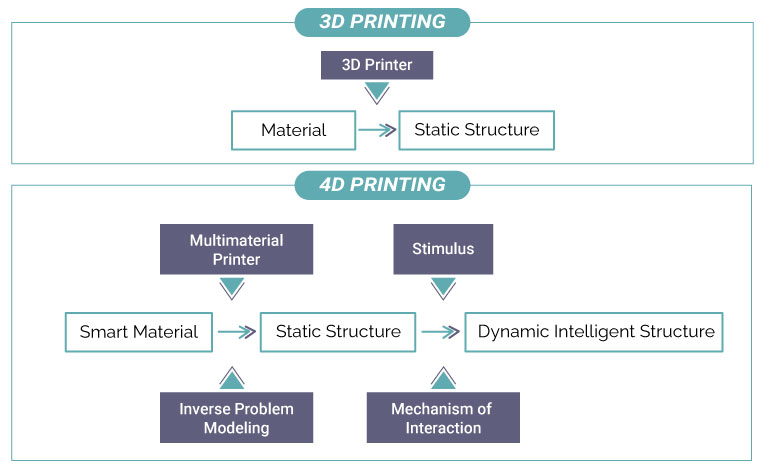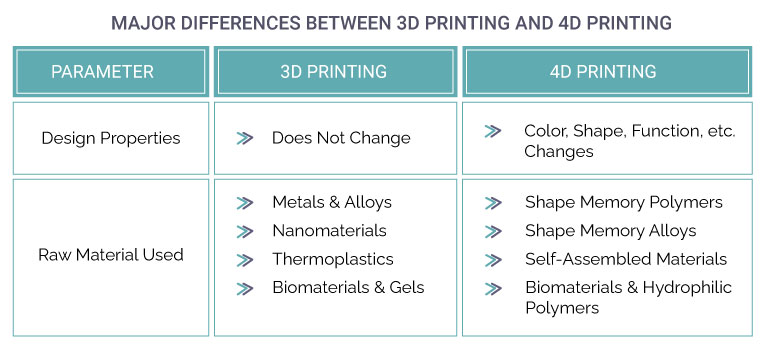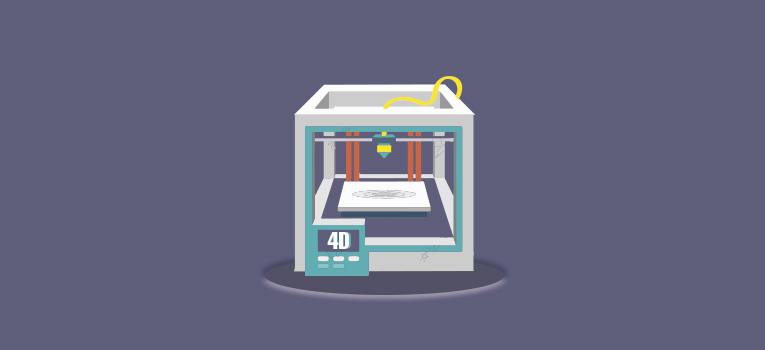4D Printing: The Future of Manufacturing
The 3D printing technology has matured as a viable solution for easily manufacturing intricate designs, even utilizing many materials. But it boosts the ultimate question of “What else can be done with it?”, this question has led many industry leaders and researchers to take the technology to a whole new level. The answer might lie in a new aspect of the technology – 4D printing.
The Technology
The term 4D printing was coined by MIT’s Self Assembly Lab. It is an advancement of 3D printing, in which the objects created by 3D printing can change their shape, size, color, function, etc., based on the requirements.
“….you first have to have the 3D manufacturing capability, and then you add smart materials….”
Howon Lee, Associate Professor, Mechanical and Space Engineering,
Rutgers University
This quote signifies that you can switch to 4D printing with the help of smart materials, and the rest of the process remains quite similar to conventional 3D printing.
4D printing is a process in which objects that have been manufactured by 3D printing convert themselves into some other structure due to the application of external input in the form of heat, light, physical stress, etc. It makes the use of programmable or Smart materials to reimage construction, manufacturing, product assembly, and performance.
Workflow in 4D Printing
The technology uses commercial 3D printers, and a “Smart Material” is used as an input, such as Hydrogel or Shape Memory Polymer, etc. These materials have special thermal, physical, or external stimulation-based properties that can perform various special changes to the manufactured product made from the process, such as shape-changing, and differentiate them from common 3D Printing Materials.


Applications of 4D Printing
With the freedom and flexibility that 4D printing provides, the applications of this technology are endless. Let’s look at some of them:
- Aerospace Industry:
Shape-changing antennas: NASA has developed a special metal fabric that can be used to shield space antennas or astronaut spacesuits. Antennas made from this material can be articulated by providing a bit of thermal stimulation or the like.
Programmable Carbon Fiber inlet components have been developed by Airbus Ltd. & MIT to cool the airplane engine by maintaining airflow automatically.
- Fashion & Clothing Industry:
The 4D printing technology can manufacture clothing and footwear that can change their properties according to the atmospheric conditions they are worn in.
For example, it can be very helpful to provide soldiers with clothes that can camouflage, cool, or insulate them according to environmental conditions.
- Healthcare Industry:
4D-manufactured artificial muscles & organs like print skins can change their shape according to the requirements and need a very small number of components for actuation. This minimizes energy consumption for powered prosthetics and wear and tear for non-powered ones.
One example of related intellectual property is CN104116578B, assigned to Xian Jiaotong University, and the patent talks about a 4D-printed artificial blood vessel bracket.
- Smart Valves for Water Handling:
Researchers have developed a valve utilizing a hybrid hydrogel as a thermal actuation element. The valve is composed of four components, each printed with a different material ink. When the hydrogel encounters hot water, the actuators contract and close the outlet to block water flow, this valve doesn’t require any electronic component to run or a complicated control system to control the actuation.
Key Benefits of 4D Printing Technology
- Limitless applications in numerous fields.
- Increases efficiency by reducing components and power use.
- Reduction in manufacturing costs.
- Highly scalable.
Some of the key players in the 4D Printing Market include 3D Systems Corporation (U.S.), Autodesk Inc. (U.S.), Airbus Ltd. (Netherlands), and Materialise NV (Belgium). They are either in collaboration with research institutes or developing in-house solutions which are yet to be commercialized.
Key Challenges Against Technology Maturation
- Availability of smart materials: One of the major challenges in making 4D printing a prominent technology is the availability and options of smart materials. There are very few options to choose from, and they are harder to obtain.
- Cost of materials involved: The cost of smart materials is also a major challenge faced by 4D printing. Materials used in this technology are not easily available, making the material expensive and limiting research opportunities.
As cost and availability of materials are the major obstacles for this technology, it also presents an opportunity for suppliers and OEMs to provide new low-cost materials and a new type of printer to accommodate new materials and assist in even more complex designing.
How Can Ingenious Help You In Exploring These Opportunities?
With our proven expertise in smart materials and 3D printing technologies, we can assist you in identifying important intellectual properties such as patents, research papers, and Journals that cater to specific problems and their solutions. This results in analyzing the strength of IP available.
By conducting Patentability and Clearance searches, we can help you determine the uniqueness and safeguarding of the solution provided by you.
We perform white space analysis for tracking the less explored areas of the domain to identify opportunities that can be focused upon and create an advantage against the competition.
We provide custom market intelligence to help you understand the shift in the additive manufacturing market from 3D to 4D printing technology.

